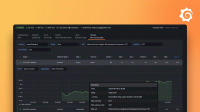Reuse and re-run tests
In the previous tutorials, you designed k6 scripts to assert performance and make comparing results easy.
In this tutorial, learn how to:
- Modularize test scripts into reusable components
- Dynamically configure scripts with environment variables
Example script
For fun, let’s combine the scripts from the previous tutorials.
Use the logic of the multiple-flows.js test with the thresholds and scenario of the api-test.js (feel free to add more checks, requests, groups, and so on).
Take note of the features of this script:
- The
defaultfunction has two groups,Contacts flow, andCoinflip game - The
optionsobject has two properties,thresholdsandscenarios
In the following sections, learn how to split these components into separate files, and combine them dynamically at run time.
Modularize logic
With modules, you can use logic and variables from other files. Use modules to extract the functions to their own files.
To do so, follow these steps:
Copy the previous script (
whole-tutorial.js) and save it asmain.js.Extract the
Contacts flowgroup function frommain.jsscript file and paste it into a new file calledcontacts.jsexport function contacts() { group('Contacts flow', function () { // save response as variable let res = http.get(`${baseUrl}/contacts.php`); // add duration property to metric contactsLatency.add(res.timings.duration); sleep(1); res = http.get(`${baseUrl}/`); // add duration property to metric contactsLatency.add(res.timings.duration); sleep(1); }); }As is, this script won’t work, since it has undeclared functions and variables.
Add the necessary imports and variables. This script uses the
group,sleep, andhttpfunctions or libraries. It also has a custom metric. Since this metric is specific to the group, you can add itcontacts.js.Finally, pass
baseUrlas a parameter of thecontactsfunction.import http from 'k6/http'; import { Trend } from 'k6/metrics'; import { group, sleep } from 'k6'; const contactsLatency = new Trend('contact_duration'); export function contacts(baseUrl) { group('Contacts flow', function () { // save response as variable let res = http.get(`${baseUrl}/contacts.php`); // add duration property to metric contactsLatency.add(res.timings.duration); sleep(1); res = http.get(`${baseUrl}/`); // add duration property to metric contactsLatency.add(res.timings.duration); sleep(1); }); }Repeat the process with the
coinflipgroup in a file calledcoinflip.js. Use the tabs to see the final three files should (optionsmoved to the bottom ofmain.jsfor better readability).Run the test:
# setting the workload to 10 iterations to limit run time k6 run main.js --iterations 10The results should be very similar to running the script in a combined file, since these are the same test.
Modularize workload
Now that the iteration code is totally modularized, you might modularize your options, too.
The following example creates a module config.js to export the threshold and workload settings.
import { coinflip } from './coinflip.js';
import { contacts } from './contacts.js';
import { thresholdsSettings, breakingWorkload } from './config.js';
export const options = {
scenarios: { breaking: breakingWorkload },
thresholds: thresholdsSettings,
};
const baseUrl = 'https://test.k6.io';
export default function () {
contacts(baseUrl);
coinflip(baseUrl);
}Notice the length of this final script and compare it with the script at the beginning of this page. Though the final execution is the same, it’s half the size and more readable.
Besides shortness, this modularity lets you compose scripts from many parts, or dynamically configure scripts at run time.
Mix and match logic
With modularized configuration and logic, you can mix and match logic. An easy way to configure this is through environment variables.
Change main.js and config.js so that it:
- By default runs a smoke test with 5 iterations
- With the right environment variable value, runs a breaking test
To do this, follow these steps:
Add the workload settings for configuring the smoke test to
config.js:export const smokeWorkload = { executor: 'shared-iterations', iterations: 5, vus: 1, }; export const thresholdsSettings = { http_req_failed: [{ threshold: 'rate<0.01', abortOnFail: true }], http_req_duration: ['p(99)<1000'], }; export const breakingWorkload = { executor: 'ramping-vus', stages: [ { duration: '10s', target: 20 }, { duration: '50s', target: 20 }, { duration: '50s', target: 40 }, { duration: '50s', target: 60 }, { duration: '50s', target: 80 }, { duration: '50s', target: 100 }, { duration: '50s', target: 120 }, { duration: '50s', target: 140 }, //.... ], };Edit
main.jsto choose the workload settings depending on theWORKLOADenvironment variable. For example:import { coinflip } from './coinflip.js'; import { contacts } from './contacts.js'; import { thresholdsSettings, breakingWorkload, smokeWorkload } from './config.js'; export const options = { scenarios: { my_scenario: __ENV.WORKLOAD === 'breaking' ? breakingWorkload : smokeWorkload, }, thresholds: thresholdsSettings, }; const baseUrl = 'https://test.k6.io'; export default function () { contacts(baseUrl); coinflip(baseUrl); }Run the script with and without the
-eflag.- What happens when you run
k6 run main.js? - What about
k6 run main.js -e WORKLOAD=breaking?
- What happens when you run
This was a simple example to showcase how you can modularize a test. As your test suite grows and more people are involved in performance testing, your modularization strategy becomes essential to building and maintaining an efficient testing suite.
Next steps
Now you’ve seen examples to write tests, assert for performance, filter results, and modularize scripts. Notice how the tests progress in complexity: from single endpoints to holistic tests, from small to large loads, and from single tests to reusable modules. These progressions are typical in testing, with the next step being to automate. It might be impractical to automate a tutorial, but if you are interested, read the Automated performance testing guide.
More likely, you want to learn more about k6. The k6-learn repository has more details to practice. Or, you can read and explore the testing guides and try to build out your testing strategy.
Happy testing!



